![]()
![]()
![]()
Use LEFT and RIGHT arrow keys to navigate between flashcards;
Use UP and DOWN arrow keys to flip the card;
H to show hint;
A reads text to speech;
80 Cards in this Set
- Front
- Back
|
Ammut |
A female demon in ancient Egyptian religion with a body that was part lion, hippopotamus and crocodile—the three largest "man-eating" animals known to ancient Egyptians. A funerary deity, her titles included "Devourer of the Dead", "Eater of Hearts", and "Great of Death". |
|
|
Ammut |
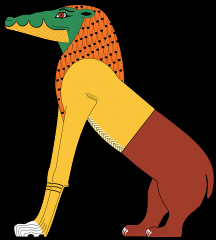
|
|
|
Amun-Ra |
As the chief deity of the Egyptian Empire, Amun-Ra also came to be worshipped outside of Egypt, in Ancient Libya and Nubia, and as Zeus Ammon came to be identified with Zeus in Ancient Greece. |
|
|
Amun-Ra |
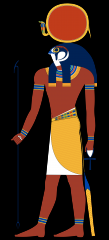
|
|
|
Anubis |
“The royal child” / god associated with mummification and the afterlife in ancient Egyptian religion, usually depicted as a canine or a man with a canine head. |
|
|
Anubis |
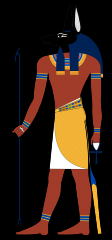
|
|
|
Apep |
Ancient Egyptian deity who embodied chaos; opponent of light and Ma’at; also a foe of Ra |
|
|
Apep |
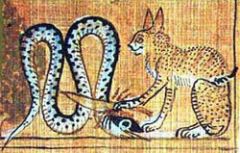
(the snake) |
|
|
Aten |
Sun disk of the god Ra; The deified is the focus of the monolatristic, henotheistic, monistic or monotheistic religion of Atenism established by Amenhotep IV |
|
|
Aten |
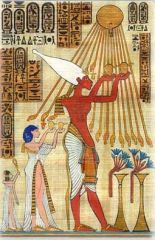
|
|
|
Atum |
Considered the first god because he created himself; “the Complete one” |
|
|
Atum |
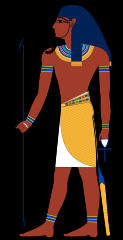
|
|
|
Babi |
Was the deification of the baboon, one of the animals present in Egypt. His name is usually translated as "bull of the baboons" |
|
|
Babi |
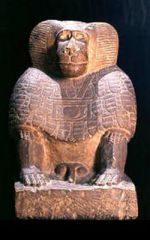
|
|
|
Bast |
The goddess of warfare in Lower Egypt, the Nile River delta region, before the unification of the cultures of ancient Egypt. Her name is also spelled Baast, Ubaste, and Baset |
|
|
Bast |
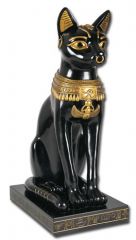
|
|
|
Bat |
A cow goddess in Egyptian mythology depicted as a human face with cow ears and horns. By the time of the Middle Kingdom, her identity and attributes were subsumed within the goddess Hathor |
|
|
Bat |

|
|
|
Bes |
God of Pregnant woman, newborn babies, and family also known to protect from snake and scorpion bites |
|
|
Bes |
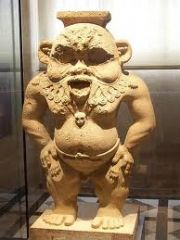
|
|
|
Geb |
God of theEarth, husband to Nut and father of Set, Osiris, Huros, Nemphys, Isos |
|
|
Geb |
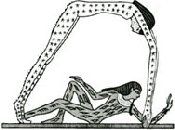
(the guy) |
|
|
Hapi |
God of the Nile |
|
|
Hapi |

|
|
|
Hathor |
Goddess of love |
|
|
Hathor |
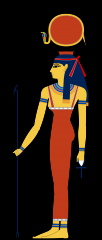
|
|
|
Heh |
God of infinity |
|
|
Heh |
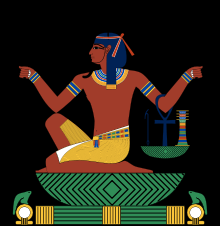
|
|
|
Heket |
Goddess of frogs |
|
|
Heket |
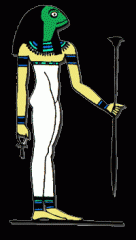
|
|
|
Horus |
God of war, sky, and falcons; son of Osiris and Isis |
|
|
Horus |

|
|
|
Imhotep |
An Egyptian polymath who served under the Third Dynasty king Djoser as chancellor to the pharaoh and high priest of the sun god Ra at Heliopolis. He is considered by some to be the earliest known architect and engineerand physician in history,though two other physicians, Hesy-Ra and Merit-Ptah, lived around the same time |
|
|
Imhotep |
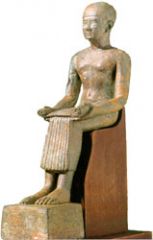
|
|
|
Isis |
Goddess of magic, marriage, healing and perfection; wife and sister of Osiris and mother of Horus |
|
|
Isis |

|
|
|
Khepera |
Khepera is a form of the sun-god Re. Khepera was specifically the god of the rising sun. He was self-produced and usually depicted as a human with a beetle on his head, or sometimes with the beetle as his head. His name comes from the Egyptian word, kheprer or "to become" |
|
|
Khepera |
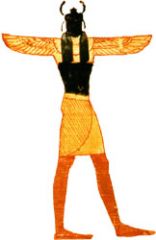
|
|
|
Khonsu |
God of the moon |
|
|
Khonsu |
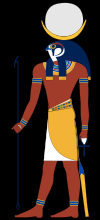
|
|
|
Ma'at |
The God of truth, balance, law, morality, and justice. She is a goddess who is depicted regulating the stars, seasons,and actions of both mortals and deities. She set the universe in order from the moment of creation |
|
|
Ma'at |
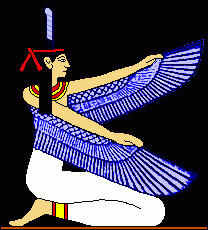
|
|
|
Nefertem |
Was originally a lotus flower at the beginning of the world, and represented the sunlight and lotus flower. He is the god of healing and beauty, and is almost always depicted with a lotus flower |
|
|
Nefertem |
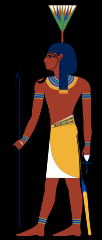
|
|
|
Neith |
The goddess of war, hunting, wisdom, and weaving. She is depicted with crossed arrows and a shield on her head, crossed ankles, and is sometimes seen wearing the red crown of Lower Egyp |
|
|
Neith |

|
|
|
Nekhbet |
Was an early predynastic local goddess in Egyptian mythology, who was the patron of the city of Nekheb (her name meaning of Nekheb). Ultimately, she became the patron of Upper Egypt and one of the two patron deities for all of Ancient Egypt when it was unified |
|
|
Nekhbet |
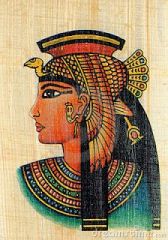
|
|
|
Nephthys |
A protective goddess of the dead. Often shown on coffins or in funeral scenes |
|
|
Nephthys |
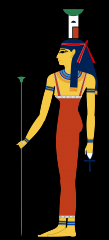
|
|
|
Mut |
“Mother” -an ancient mother goddess who changed over thousands of years of culture. Goddess of heaven, is shown with a royal culture headdress and crowns of both Upper and Lower Egypt |
|
|
Mut |
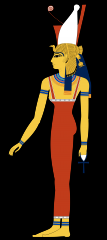
|
|
|
Nun |
Meaning abyss, is the deification of the primordial watery abyss in ancient Egyptian culture |
|
|
Nun |
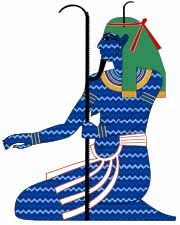
|
|
|
Nut |
The personification of the sky, stars, sun, moon, astronomy, air, the universe, winds and heavens. She is said to be the mother of Ra, and is wearing a water pot |
|
|
Nut |
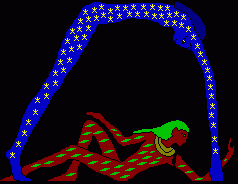
(the girl) |
|
|
Osiris |
The god of death, life, afterlife, and resurrection. He is depicted with black green skin, symbolizing rebirth |
|
|
Osiris |

|
|
|
Ptah |
The god of craftsmen and architects, the arts, and fertility. and is depicted as a mummified man |
|
|
Ptah |

|
|
|
Re (Ra) |
God of Sun, sometimes known as the creator of men, and had the head of a hawk |
|
|
Ra |
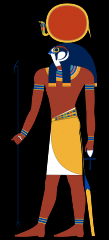
|
|
|
Satet |
Archer Goddess of the Nile Cataracts. She was the known protector of the Pharaohs |
|
|
Satet |

|
|
|
Sekhmet |
Goddess of war and vengeance, had the head of a lion, she was created by Ra to destroy men for not worshipping him |
|
|
Sekhmet |
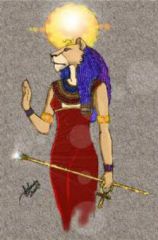
|
|
|
Selket |
Goddess of scorpions, medicine, magic, and healing. on her head rests a scorpion. She was alsoone of the people who watched over one of the four sons of Horus |
|
|
Selket |
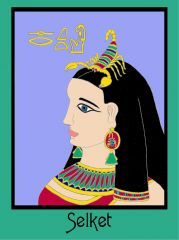
|
|
|
Seth |
God of chaos, desert, storms, and foreigners. He was a human cross between someone unknown animal |
|
|
Seth |
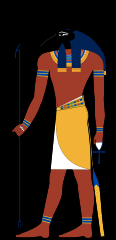
|
|
|
Shu |
God of wind and air, was believed to hold ladder to heaven for the dead |
|
|
Shu |

|
|
|
Sobek |
God of crocodiles and alligators |
|
|
Sobek |

|
|
|
Tawaret |
Goddess of childbirth and fertility |
|
|
Tawaret |
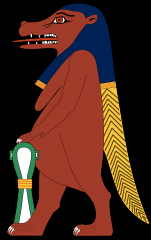
|
|
|
Tefnut |
Lion goddess of water and fertility |
|
|
Tefnut |
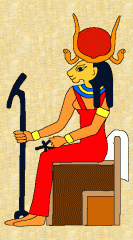
|
|
|
Thoth |
Scribe god, god of wisdom, wrote the Egyptian Book of the Dead |
|
|
Thoth |
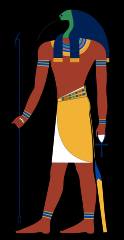
|

